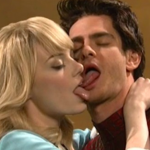Last week, the ABC reported that Home and Away had cut at least three scenes involving a lesbian couple, and another scene was reported to have been cut this morning.
Grab your petticoats and corsets folks, because it looks like we’re going back in time.
Three of the four missing scenes we know about showed the characters, Willow and Alex (Willex if you’re a fan) kissing. Channel Seven blamed “human error” for the wrong copies of the episodes going to air last year, but fans online are calling bullshit, and so am I.
Of course, there’s always heaps of post-production and editing that goes on before an episode ends up on our screens, but I want to know why these scenes were cut at all. Is Home and Away airing in Russia?
Home and Away appears to cut another gay kiss scene, as actors involved speak out https://t.co/snrzFZOINt
— ABC News (@abcnews) February 3, 2020
LGBTQ+ representation in Australian media feels really bleak, so knowing that multiple scenes were axed to downplay the intimacy of a lesbian couple touches a nerve. Despite conservatives like Lyle Shelton telling the world that the rainbow agenda is taking over, Australia is really lagging behind when it comes to queers on our screens, even though we were the first country in the world to have central gay, lesbian, and transgender characters on telly – even beating the US.
Yep, you read that right, Australian media was actually quite progressive once upon a time.
Don Finlayson was an openly gay character on the soap Number 96 in 1972. To give you a little perspective on how radical this was, homosexuality was still illegal, Mardi Gras was still six years away, and America didn’t have a gay character on TV until almost two decades later. Not only was Don gay, but he was written without the “flaming queen” stereotypes that often accompany early representations of gay men on screen.
The world’s first transgender character, Robyn Ross, was on the same show only a year later, and was played by Carlotta, a trans woman herself. Trans actors playing trans characters is something movies and television can’t even get right in 2020, so Robyn’s portrayal is hugely important even today.
In the same year, Marie was TV’s first lesbian, and The Box had the first gay kiss in 1974 between Felicity and Vicki, who, as far as I can find, might have been the first bisexual represented on TV.
So Why Are TV Executives Cutting Out Lesbian Kisses Now?
Queer characters in Australian shows still feel few and far between. In 2016, Screen Australia’s study into diversity on Australian television dramas found that only 5% of main characters fell under the LGBTQ+ umbrella. Most of that tiny fraction is likely made up by cisgender, white, gay men, who absolutely dominate LGBTQ+ rep.
There’s been a few stand out shows in the last few years that come to mind when talking about important queer representation- Please Like Me, Wentworth, The Heights, The Family Law, Janet King – but even these handful of shows are pretty limited on their portrayals. We need more queer characters who are trans, Indigenous, disabled, Muslim, interracial, non-binary, poor. These people exist and deserve to have their stories heard.
I’ve been thinking a lot about why the whole cutting #willex scenes/ kisses has had a big impact on me. I jotted down some thoughts pic.twitter.com/dM4HMGPlc8
— Phoebe (@PhoebeTheAussie) January 30, 2020
Meaningful queer representation in Australian media is severely stunted, and it has a notable impact on our communities. It’s not just a few kisses that Channel Seven tried to erase, but the normalisation of love between two queer women. Don’t let people erase radical queer characters on Australian TV and pretend that this is the way it has always been. We owe it to LGBTQ+ Australians, especially young ones, to do better.
Image Sources: Seven Plus, GIPHY




